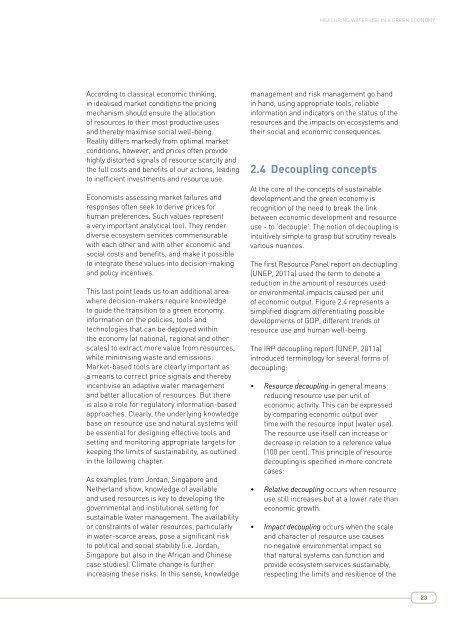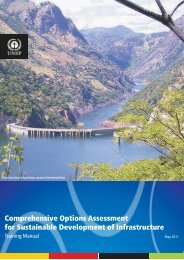MEASURING WATER USE IN A GREEN ECONOMY - UNEP
MEASURING WATER USE IN A GREEN ECONOMY - UNEP
MEASURING WATER USE IN A GREEN ECONOMY - UNEP
You also want an ePaper? Increase the reach of your titles
YUMPU automatically turns print PDFs into web optimized ePapers that Google loves.
Measuring water use in a green economy<br />
According to classical economic thinking,<br />
in idealised market conditions the pricing<br />
mechanism should ensure the allocation<br />
of resources to their most productive uses<br />
and thereby maximise social well-being.<br />
Reality differs markedly from optimal market<br />
conditions, however, and prices often provide<br />
highly distorted signals of resource scarcity and<br />
the full costs and benefits of our actions, leading<br />
to inefficient investments and resource use.<br />
Economists assessing market failures and<br />
responses often seek to derive prices for<br />
human preferences. Such values represent<br />
a very important analytical tool. They render<br />
diverse ecosystem services commensurable<br />
with each other and with other economic and<br />
social costs and benefits, and make it possible<br />
to integrate these values into decision-making<br />
and policy incentives.<br />
This last point leads us to an additional area<br />
where decision-makers require knowledge<br />
to guide the transition to a green economy:<br />
information on the policies, tools and<br />
technologies that can be deployed within<br />
the economy (at national, regional and other<br />
scales) to extract more value from resources,<br />
while minimising waste and emissions.<br />
Market-based tools are clearly important as<br />
a means to correct price signals and thereby<br />
incentivise an adaptive water management<br />
and better allocation of resources. But there<br />
is also a role for regulatory information-based<br />
approaches. Clearly, the underlying knowledge<br />
base on resource use and natural systems will<br />
be essential for designing effective tools and<br />
setting and monitoring appropriate targets for<br />
keeping the limits of sustainability, as outlined<br />
in the following chapter.<br />
As examples from Jordan, Singapore and<br />
Netherland show, knowledge of available<br />
and used resources is key to developing the<br />
governmental and institutional setting for<br />
sustainable water management. The availability<br />
or constraints of water resources, particularly<br />
in water-scarce areas, pose a significant risk<br />
to political and social stability (i.e. Jordan,<br />
Singapore but also in the African and Chinese<br />
case studies). Climate change is further<br />
increasing these risks. In this sense, knowledge<br />
management and risk management go hand<br />
in hand, using appropriate tools, reliable<br />
information and indicators on the status of the<br />
resources and the impacts on ecosystems and<br />
their social and economic consequences.<br />
2.4 Decoupling concepts<br />
At the core of the concepts of sustainable<br />
development and the green economy is<br />
recognition of the need to break the link<br />
between economic development and resource<br />
use - to ‘decouple’. The notion of decoupling is<br />
intuitively simple to grasp but scrutiny reveals<br />
various nuances.<br />
The first Resource Panel report on decoupling<br />
(<strong>UNEP</strong>, 2011a) used the term to denote a<br />
reduction in the amount of resources used<br />
or environmental impacts caused per unit<br />
of economic output. Figure 2.4 represents a<br />
simplified diagram differentiating possible<br />
developments of GDP, different trends of<br />
resource use and human well-being.<br />
The IRP decoupling report (<strong>UNEP</strong>, 2011a)<br />
introduced terminology for several forms of<br />
decoupling:<br />
• Resource decoupling in general means<br />
reducing resource use per unit of<br />
economic activity. This can be expressed<br />
by comparing economic output over<br />
time with the resource input (water use).<br />
The resource use itself can increase or<br />
decrease in relation to a reference value<br />
(100 per cent). This principle of resource<br />
decoupling is specified in more concrete<br />
cases:<br />
• Relative decoupling occurs when resource<br />
use still increases but at a lower rate than<br />
economic growth.<br />
• Impact decoupling occurs when the scale<br />
and character of resource use causes<br />
no negative environmental impact so<br />
that natural systems can function and<br />
provide ecosystem services sustainably,<br />
respecting the limits and resilience of the<br />
23

















